

Why is your teenager being disrespectful? About disrespectful behaviour in teenagers Sometimes you might feel that interactions with your child all seem a bit like this: You – ‘How’s that project going?’

Your child – ‘Why are you checking up on me? Brain changes during adolescence. The Teenage Brain and its Effects on Behavior. Communication and the Teenage Brain. Summary. Skinner’s Operant Conditioning: Rewards & Punishments. [5:51] Operant Conditioning. Summary of Reinforcement and Punishment (Source: PsychIRL) Summary of Operant Conditioning. Positive vs. Negative Reinforcement. There are two types of reinforcement: positive and negative.

You may have had moments where one of these forms of reinforcement worked well for you, while another stirred up feelings of shame or resentment. Have you ever rewarded a child with candy for good behavior? That is an example of positive reinforcement. Shaping Behavior through Reinforcement. How Reinforcement Schedules Work. Operant conditioning is a learning process in which new behaviors are acquired and modified through their association with consequences.
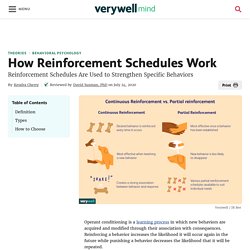
Reinforcing a behavior increases the likelihood it will occur again in the future while punishing a behavior decreases the likelihood that it will be repeated. In operant conditioning, schedules of reinforcement are an important component of the learning process. When and how often we reinforce a behavior can have a dramatic impact on the strength and rate of the response.
Schedule of Reinforcement. Positive and Negative Reinforcement Underlying Risk Behavior in Early Adolescents. Summary of Reinforcement. Positive vs. Negative Reinforcement: A Guide for Parents. I almost stopped bringing them to the playground.
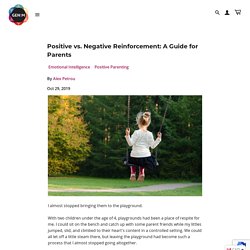
With two children under the age of 4, playgrounds had been a place of respite for me. I could sit on the bench and catch up with some parent friends while my littles jumped, slid, and climbed to their heart's content in a controlled setting. We could all let off a little steam there, but leaving the playground had become such a process that I almost stopped going altogether. Inevitably, when I announced it was time to go, my 3-year-old would run away. Laughing maniacally, he’d climb a slide or shimmy to the top of a play structure and gleefully gaze down at me as though it was a joke, as though dinner didn’t need to be made and naps didn’t need to happen. Parenting A Teen through Positive Reinforcement. Most parents can agree: the teenage years can be rough!

Hormones are raging, they are trying to gain more independence, and they spend a lot of time away from their parents and their home while hanging with friends. One minute they love and adore you, the next minute you ruined their life. Can many of you relate? When tempers flare and disagreements are happening, it’s hard to not resort to yelling and harsh discipline, but studies are showing us that positive reinforcement may be the key to success, not just in the home but also in their school life. Parenting Children with Positive Reinforcement (Examples + Charts) Children don’t come with instructions and discipline is often experienced by parents and children alike as an arena where our will and wits are tested.
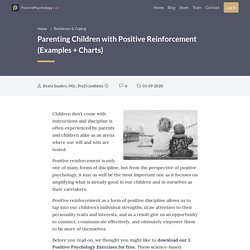
Positive reinforcement is only one of many forms of discipline, but from the perspective of positive psychology, it may as well be the most important one as it focuses on amplifying what is already good in our children and in ourselves as their caretakers. Positive reinforcement as a form of positive discipline allows us to tap into our children’s individual strengths, draw attention to their personality traits and interests, and as a result give us an opportunity to connect, communicate effectively, and ultimately empower them to be more of themselves. Before you read on, we thought you might like to download our 3 Positive Psychology Exercises for free. You can download the free PDF here. A Look at Parenting with Positive Reinforcement. Using Positive Reinforcement to Improve Behavior. When your child misbehaves, rewards might be the last thing on your mind.
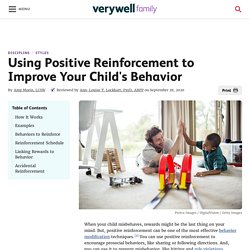
But, positive reinforcement can be one of the most effective behavior modification techniques.1 You can use positive reinforcement to encourage prosocial behaviors, like sharing or following directions. And, you can use it to prevent misbehavior, like hitting and rule violations. Positive reinforcement can also be an effective way to encourage and motivate your child to be responsible, do their chores, get along with their siblings, or complete their homework assignments without arguing. How Positive Reinforcement Works. Negative Reinforcement as a Parenting Technique. You've heard of negative reinforcement, but how do you put it into practice?
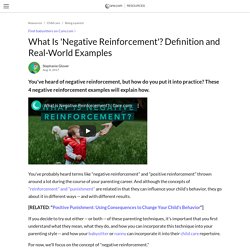
These 4 negative reinforcement examples will explain how. You've probably heard terms like "negative reinforcement" and "positive reinforcement" thrown around a lot during the course of your parenting career. And although the concepts of "reinforcement" and "punishment" are related in that they can influence your child's behavior, they go about it in different ways -- and with different results.
[RELATED: "Positive Punishment: Using Consequences to Change Your Child's Behavior"] Positive vs. Negative Punishment. Punishment is a fundamental concept of Operant Conditioning, whose major objective is to decrease the rate of certain undesired behavior from occurring again.
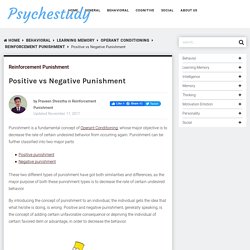
Punishment can be further classified into two major parts These two different types of punishment have got both similarities and differences, as the major purpose of both these punishment types is to decrease the rate of certain undesired behavior. By introducing the concept of punishment to an individual, the individual gets the idea that what he/she is doing, is wrong. Summary of Punishment. The Difference Between Positive and Negative Punishment in Parenting. Positive vs. Negative Punishment: Examples and Differences.
Before exploring the topic of positive and negative punishment, we first need to make sure that we understand the language used in discussing these types of behavior modification.

Even the term “behavior modification” sounds ominous, conjuring up images of an overbearing teacher rapping the knuckles of a disobedient child with a wooden ruler. In fact, almost all parents, teachers, and caregivers practice some form of behavior modification. In essence, behavior modification simply means providing undesirable consequences for an undesired behavior (like refusing to put on shoes) in order to shift the individual to the desired behavior (like putting on shoes when asked). Behavior modification evolved from a version of operant conditioning as made prominent by renowned psychologist, B. F. Positive Punishment: What It Is, Benefits, and Examples. Positive punishment is a form of behavior modification. In this case, the word “positive” doesn’t refer to something pleasant. Positive punishment is adding something to the mix that will result in an unpleasant consequence. How Negative Punishment Works.
Negative punishment is an important concept in B. F. Skinner's theory of operant conditioning. In behavioral psychology, the goal of punishment is to decrease unwanted behavior. In the case of negative punishment, it involves taking something good or desirable away to reduce the occurrence of a particular behavior. One of the easiest ways to remember this concept is to note that in behavioral terms, positive means adding something while negative means taking something away. Guidelines for Using Punishment on Teenagers. Image: Shutterstock Your teenage child has broken a fundamental rule, and what they have done could have ended disastrously for them and others.
You know that they need to face the consequences for misbehavior. They should understand how wrong they were and why they should never repeat this mistake. This is where the question of punishment arises. Reinforcement learning across development: What insights can we draw from a decade of research? Abstract The past decade has seen the emergence of the use of reinforcement learning models to study developmental change in value-based learning. It is unclear, however, whether these computational modeling studies, which have employed a wide variety of tasks and model variants, have reached convergent conclusions.
In this review, we examine whether the tuning of model parameters that govern different aspects of learning and decision-making processes vary consistently as a function of age, and what neurocognitive developmental changes may account for differences in these parameter estimates across development. We explore whether patterns of developmental change in these estimates are better described by differences in the extent to which individuals adapt their learning processes to the statistics of different environments, or by more static learning biases that emerge across varied contexts. Keywords. Rewarding behavior is key to parenting teens, study suggests.
Parenting is hard, and parenting teens brings about an entirely new set of challenges, from keeping their rooms clean to getting them home before curfew. But, a new study suggests parents who want their teenagers to keep their grades up could have better success if they focus more on rewarding good behavior and less on threatening to punish the bad. According to the report, published in PLOS Computational Biology, British researchers have found that adolescents focus well on positive incentives, but have difficulty staying motivated to avoid penalties. Simple reward-based learning suits adolescents best. Psychologists suggest that rewards decrease our natural motivation and enjoyment. Adolescent learning: rewards, punishments, and the importance of context. Punishing a child is effective if done correctly. Conclusion.